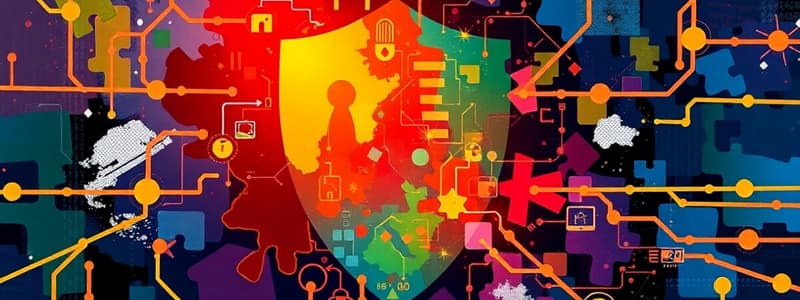Podcast
Questions and Answers
Which of the following is NOT a typical objective of an access attack?
Which of the following is NOT a typical objective of an access attack?
- System access
- Network reconnaissance (correct)
- Privilege escalation
- Data retrieval
What is the primary purpose of a ping sweep in the context of network attacks?
What is the primary purpose of a ping sweep in the context of network attacks?
- To flood a target with packets.
- To identify active IP addresses. (correct)
- To redirect network traffic.
- To exploit software vulnerabilities.
Which attack involves manipulating a network to misdirect traffic?
Which attack involves manipulating a network to misdirect traffic?
- Man-in-the-middle
- MAC spoofing
- Buffer overflow
- Port redirection (correct)
Social engineering attacks rely most significantly on what to be successful?
Social engineering attacks rely most significantly on what to be successful?
What is a botnet primarily used for in DDoS attacks?
What is a botnet primarily used for in DDoS attacks?
Which of these security measures is primarily used for inside perimeter security?
Which of these security measures is primarily used for inside perimeter security?
Which of the following best characterizes the evolution of modern hacking titles?
Which of the following best characterizes the evolution of modern hacking titles?
Which of the following is a tool specifically designed for identifying and exploiting network vulnerabilities?
Which of the following is a tool specifically designed for identifying and exploiting network vulnerabilities?
Which of these activities is not typically associated with penetration testing tools?
Which of these activities is not typically associated with penetration testing tools?
Which security measure would be most effective in deterring unauthorized physical access into a data center?
Which security measure would be most effective in deterring unauthorized physical access into a data center?
Which of the following best describes a 'threat' in the context of network security?
Which of the following best describes a 'threat' in the context of network security?
Which of the following is NOT explicitly identified as a vector of data loss?
Which of the following is NOT explicitly identified as a vector of data loss?
A company operates a large office building with multiple interconnected local networks. This setup is best described as which type of network?
A company operates a large office building with multiple interconnected local networks. This setup is best described as which type of network?
In the context of network security, what does 'mitigation' primarily refer to?
In the context of network security, what does 'mitigation' primarily refer to?
Which of the options, presents a common means of data loss, where physical controls would be useful?
Which of the options, presents a common means of data loss, where physical controls would be useful?
What technique is used to ensure that the data is not only available but also protected from unauthorized access?
What technique is used to ensure that the data is not only available but also protected from unauthorized access?
In the context of network security, which of the following describes the concept of integrity?
In the context of network security, which of the following describes the concept of integrity?
What is the primary goal of the Cisco SecureX Architecture?
What is the primary goal of the Cisco SecureX Architecture?
Which of the following domains must be collectively addressed to effectively protect a network?
Which of the following domains must be collectively addressed to effectively protect a network?
Which method is NOT typically used to mitigate common network attacks?
Which method is NOT typically used to mitigate common network attacks?
A "Trojan Horse" malware classification that disables security software is known as a "Data-Sending" Trojan.
A "Trojan Horse" malware classification that disables security software is known as a "Data-Sending" Trojan.
One of the stages in the propagation cycle of a Code Red Worm is "Dormant for a few days".
One of the stages in the propagation cycle of a Code Red Worm is "Dormant for a few days".
Eavesdropping, a common network hacking attack, is the act of intercepting and listening to network traffic.
Eavesdropping, a common network hacking attack, is the act of intercepting and listening to network traffic.
The "Payload" component of a worm is responsible for enabling the worm's vulnerability, allowing it to spread.
The "Payload" component of a worm is responsible for enabling the worm's vulnerability, allowing it to spread.
The classification of "Remote-access" Trojan Horse malware allows attackers to remotely control the user's device.
The classification of "Remote-access" Trojan Horse malware allows attackers to remotely control the user's device.
Risk, in network security, refers to a potential exploitable weakness in a network.
Risk, in network security, refers to a potential exploitable weakness in a network.
Hard copies of documents are not considered a potential vector for data loss.
Hard copies of documents are not considered a potential vector for data loss.
A Wide Area Network (WAN) is typically used to connect multiple buildings within a single office campus.
A Wide Area Network (WAN) is typically used to connect multiple buildings within a single office campus.
Cloud storage devices are not considered a potential vector for data loss as they are secured by service providers.
Cloud storage devices are not considered a potential vector for data loss as they are secured by service providers.
Mitigation is the process of completely eliminating all vulnerabilities in a network environment.
Mitigation is the process of completely eliminating all vulnerabilities in a network environment.
DDoS attacks rely on a single infected machine to execute the attack.
DDoS attacks rely on a single infected machine to execute the attack.
Scareware is a type of malware designed primarily to modify data.
Scareware is a type of malware designed primarily to modify data.
Access attacks can include techniques such as buffer overflow and man-in-the-middle.
Access attacks can include techniques such as buffer overflow and man-in-the-middle.
Social engineering attacks include techniques like reconnaissance and denial of service.
Social engineering attacks include techniques like reconnaissance and denial of service.
DDoS attacks are typically carried out by a botnet of zombies controlled by a hacker.
DDoS attacks are typically carried out by a botnet of zombies controlled by a hacker.
Phishing and spearphishing are both types of social engineering attacks.
Phishing and spearphishing are both types of social engineering attacks.
Confidentiality in network security primarily ensures that data is accessible.
Confidentiality in network security primarily ensures that data is accessible.
The CIA triad stands for Confidentiality, Integrity, and Availability in network security.
The CIA triad stands for Confidentiality, Integrity, and Availability in network security.
Integrity in network security involves using encryption to protect data.
Integrity in network security involves using encryption to protect data.
Availability in network security means that data is effectively hidden from unauthorized users.
Availability in network security means that data is effectively hidden from unauthorized users.
Flashcards
Vulnerability
Vulnerability
A weakness or flaw in a system or its security measures that can be exploited by an attacker.
Threat
Threat
Any potential event or action that could negatively impact the confidentiality, integrity, or availability of information or systems.
Mitigation
Mitigation
Actions taken to reduce the likelihood or impact of a threat.
Risk
Risk
Signup and view all the flashcards
Campus Area Network (CAN)
Campus Area Network (CAN)
Signup and view all the flashcards
Confidentiality
Confidentiality
Signup and view all the flashcards
Integrity
Integrity
Signup and view all the flashcards
Availability
Availability
Signup and view all the flashcards
Network Security Professionals
Network Security Professionals
Signup and view all the flashcards
Network Security Organizations
Network Security Organizations
Signup and view all the flashcards
Hackers
Hackers
Signup and view all the flashcards
Cyber Criminals
Cyber Criminals
Signup and view all the flashcards
Hacktivists
Hacktivists
Signup and view all the flashcards
Attack Tools
Attack Tools
Signup and view all the flashcards
Penetration Testing
Penetration Testing
Signup and view all the flashcards
Reconnaissance Attacks
Reconnaissance Attacks
Signup and view all the flashcards
Access Attacks
Access Attacks
Signup and view all the flashcards
Phishing Attacks
Phishing Attacks
Signup and view all the flashcards
Denial of Service (DoS) Attacks
Denial of Service (DoS) Attacks
Signup and view all the flashcards
Distributed Denial of Service (DDoS) Attacks
Distributed Denial of Service (DDoS) Attacks
Signup and view all the flashcards
What is a threat?
What is a threat?
Signup and view all the flashcards
Worm
Worm
Signup and view all the flashcards
What is a vulnerability?
What is a vulnerability?
Signup and view all the flashcards
Trojan Horse
Trojan Horse
Signup and view all the flashcards
What is mitigation?
What is mitigation?
Signup and view all the flashcards
What is risk?
What is risk?
Signup and view all the flashcards
Virus
Virus
Signup and view all the flashcards
Denial-of-service attack
Denial-of-service attack
Signup and view all the flashcards
What is a Campus Area Network (CAN)?
What is a Campus Area Network (CAN)?
Signup and view all the flashcards
Man-in-the-middle attack
Man-in-the-middle attack
Signup and view all the flashcards
Botnet
Botnet
Signup and view all the flashcards
Zombies
Zombies
Signup and view all the flashcards
Pretexting
Pretexting
Signup and view all the flashcards
Network Security
Network Security
Signup and view all the flashcards
Study Notes
Chapter 1: Modern Network Security Threats
- This chapter discusses modern network security threats.
- The course is CCNA Security v2.0 taught by Dr. Nadhir Ben Halima.
- The chapter outline includes Introduction, Securing Networks, Network Threats, Mitigating Threats, and Summary.
Section 1.1: Securing Networks
- Upon completion, students should describe the current network security landscape.
- They should also explain why all types of networks need protection.
Topic 1.1.1: Current State of Affairs
- Networks are targets for attacks.
- Specific attack origins and targets are tracked and visible.
- Attack types and associated attack tools are recorded.
Topic 1.1.2: Network Topology Overview
- Different network topologies exist, each with security needs:
- Campus Area Networks (CAN): Includes AAA servers, firewalls, VPNs, IPS, Layer 3 and 2 switches, DHCP and web servers
- Small Office/Home Office (SOHO) Networks: Typically uses wireless router, layer 2 switch
- Wide Area Networks (WAN): Connects multiple locations (branch, regional, corporate) via Point of Presence (POP) and VPN connections. A Cisco ASA firewall is often used at each connection.
- Data Center Networks: Outside perimeter typically has security personnel, fences, security cameras and alarms. The inside perimeter has electronic motion detectors, security traps (often security cameras), and biometric access/exit sensors.
Section 1.2: Network Threats
- Students should understand the evolution of network security.
- They should describe various attack tools used by hackers.
- Students should describe malware, and explain common network attacks.
Topic 1.2.1: Who is Hacking Our Networks?
- Modern hacking titles include script kiddies, vulnerability brokers, hacktivists, cybercriminals, and state-sponsored hackers.
- The motivations and capabilities of different hacker groups vary.
Topic 1.2.2: Hacker Tools.
- Sophistication of Attacker Tools and Technical Knowledge Needed is constantly changing over time. Tools range from simple scripts to complex exploits.
Topic 1.2.3: Malware
- Malware types include viruses, worms, and Trojan horses, each with different characteristics and propagation methods.
- Examples of specific malware variations are: Adware, Spyware, Ransomware, Scareware, and Rootkits, Phishing.
Topic 1.2.4: Common Network Attacks
- Different types of attacks exist, including reconnaissance, access attacks, denial-of-service (DoS), and distributed denial-of-service (DDoS) attacks.
- Reconnaissance: Attacks involve initial queries of a network to see what's there, ping sweeps, port scans, and using vulnerability scanners and exploitation tools to discover potential vulnerabilities and weaknesses.
- Access Attacks: These attacks typically include password-based attacks, port redirection, man-in-the-middle attacks, buffer overflows, and IP/MAC/DHCP spoofing.
- Denial of Service (DoS): Attacks flood a system/network with requests, preventing legitimate users from accessing the resource.
- Distributed Denial of Service (DDoS) Attacks: Coordinated attacks from multiple sources/computers flood a resource, making it unresponsive.
Section 1.3: Mitigating Threats
- Students should describe methods and resources to protect networks.
- They need to describe domains in network security.
- Explain Cisco SecureX architecture.
- Describe techniques to mitigate network attacks.
- Explain the security of Cisco routers/switches.
Topic 1.3.1: Defending the Network
- Best practices include creating security policies, training employees about risks (social engineering), controlling physical access to systems, using strong passwords, encrypting sensitive data, using security hardware, performing backups, shutting down unnecessary services, and keeping software up to date, installing and using appropriate security software .
Topic 1.3.2: Domains of Network Security
- Numerous domains covered in network security, including risk assessment, security policy, information security organization, asset management, human resources security, physical security, communications/operations management, and information systems acquisition, development, maintenance
Topic 1.3.3: Network Security Policy
- Security policies are crucial to establishing access rules, particularly for remote workers.
Topic 1.3.4: Mitigating Common Network Threats
- Best practices for mitigating various types of network threats, such as malware effects and general network attacks. Techniques to mitigate specific threats like worms are covered.
Topic 1.3.5: Cisco Network Foundation Protection Framework
- This framework describes how to secure the control, management, and data planes of a network.
- Control Plane: Protects the routing protocols and IP routing tables using authentication, policing or AutoSecure.
- Management Plane: Secures the processes and management sessions, using login policies, legal notifications, role-based access control, and authorization and reporting to control access to sensitive data.
- Data Plane: Protects the forwarding table using access control lists (ACLs). Antispoofing is used, as well as Layer 2 security including port security, DHCP snooping, and Dynamic ARP Inspection (DAI)
Section 1.4: Summary
- Main objectives of the chapter are explained:
- Network security explanation
- Description of threats and attacks
- Methods and tools to mitigate malware and network attacks
Studying That Suits You
Use AI to generate personalized quizzes and flashcards to suit your learning preferences.




